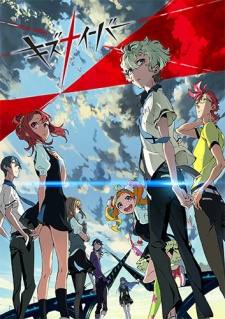
I think the folks at Studio Trigger have inadvertently found a good niche for themselves. Kiznaiver tells a story of a group of seven high schoolers who are kidnapped and surgically altered to share one another’s pain, and because they are high schoolers this follows an inevitable progression from comically sharing physical pain with slapstick to slowly sharing emotional pain and opening up to one another in the process. It’s either characteristic of the genre or characteristic of scriptwriter Okada Mari, who is unsurprisingly the mind behind works such as anohana: The Flower We Saw That Day and A Lull in the Sea. Still her writing is solid enough, sometimes stepping into realm of melodrama, sometimes keeping the reins steady and under control. But the real success in Kiznaiver lies in the absurdist elements that Trigger brings to the table, with an exotic soundtrack, heavily contrasting pastel colors, and no shortage of odd angles and designs to be found.
Because when I say Kiznaiver skates the boundary of melodrama, I mean that it skates the boundary so hard I'm actually surprised I enjoyed the show at all, and it completely lies in the general aesthetic. As far as it goes as a character piece, there’s no new ground really being broken. The closest is the protagonist Katsuhira, who hasn’t felt physical pain since he was a child and has developed an inexpressive personality and emotional density to match with it, because there is an interesting clash between his monotone voice or frozen facial expression and the increasingly extreme words and feelings he says with them. As for the other students, who are given the name Kiznaivers as derived from the Japanese word for injury, they are described by their kidnapper Noriko in the first episode as “the cunning normal,” “high-and-mighty,” “goody-two-shoes,” “the eccentric headcase,” “the muscle-headed thug,” and “immoral,” and these names sum up most of what we need to know of them for the rest of the show. Although true to her name, the eccentric headcase is always good for getting the party going on screen.
The process that leads to them opening up and embracing their friendship is arduous, a mix of the supernatural connection they share as Kiznaivers and the more mundane aspects of trying to avoid all the crazy challenges Noriko and her backing organization throw at them. There are at least three times where the whole group argues over whether or not they are already friends, with us knowing that they’ll all come around to admitting it by the end. But interspersed with the more mundane slapstick and the more contrived emotional growth that comes from time to time are some clever plot twists or tense moments borne from a sudden shock to the plot, aided by the striking imagery both in terms of color contrast and in terms of overall visual design. When their emotional pain reaches a head towards the end and they find their bonds growing too uncomfortable to sustain their friendship, amidst the arguing and revealing of love interests there is a beautiful shot of the sunset, framing all seven of them looking in different directions, physically separated by as much space as the narrow shot allows and conveying an even greater emotional rift. The other striking shot is a recurring image of the bridge connecting their city to the outside world raised to form an X, visually representative of the cross all the Kiznaivers bear on their arms as a sign of their bond but also signaling a separation, from the outside world and from each other, as the two parts of the X appear to touch but never actually do.
There's both pervasive comedy in their group discussions borne of their comically different personalities and in the way in which Kiznaiver handles exposition and the forced progression of the plot from outside the Kiznaiver circle. In the scene where they're kidnapped and brought to the hospital for their operation, each is shown being ambushed by a group of human-sized plushies called Gomorin, with oblong heads, no mouths, and giant spherical eyes to create an image not at all unlike Paranoia Agent’s Satanic cartoon icon Maromi. The Gomorin always show up to put the Kiznaivers under stress to force a physical or emotional reaction from them, but seeing a row of them each dressed as a different Halloween character or delinquent archetype doesn’t make for the most stressful of situations, a fact that Kiznaiver is careful never to forget. As for the Kiznaivers themselves, at episode three we meet the seventh one, and their choice of a personality to complete a group of pain-sharing high schoolers was perfect to say the least, albeit terrifying to actually imagine.
There is a rapid interweaving of the past and present as Noriko moves from behind the scenes to becoming an active participant in the Kiznaivers’ development, and while there is some notion that she shares a history with Katsuhira given how they grow closer despite having identically flat and unexpressive personalities, the actual reveals provide a good counterpoint to the current time. Unfortunately only one of the other Kiznaivers receives any real backstory, which makes that story ultimately feel out of place and unnecessary despite being some of the few episodes that actually deconstruct the characters. It ends up being good that the focus is on the dual leads of Katsuhira and Noriko, because with only twelve episodes the standard formula of rotating between character backstories would have left no time to delve into the more interesting aspects of the setting and the Kiznaiver experiments. And given that decision, it may have been better if they cut out the other backstories completely, which would have left more time for Okada’s plot to shine and even more time for Trigger’s bizarre fantasy world to keep us laughing. Thankfully there’s still enough of both to go around.